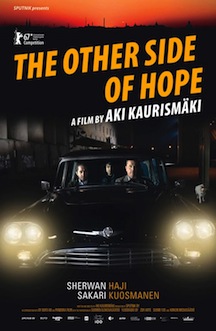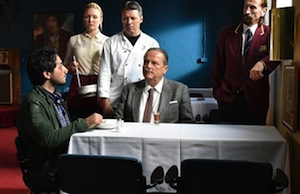Directed by Aki Kaurismaki
Country: Finland
Using his extraordinary filmmaking artistry, Finnish director Aki Kaurismaki, who won his first Silver Berlin Bear this year, aims once more at the immigration hardships in his new comedy-drama “The Other Side of Hope”. Following the same steps given in his previous feature, “Le Havre”, which addressed the same topic but having the French harbor as the backdrop, the director relies on an overwhelming sense of absurdity, graceful wit, and sharp socio-political observations to tell a story packed with flourishing humanity and personal triumphs, but also touched by condemnable malice.
Involved in an absorbing quietude, the story brings two contrasting yet interesting characters to the forefront. If Waldemar Wikstrom (Sakari Kuosmanen) is a bored Finnish citizen who resolutely abandons his unresponsive, alcoholic wife and decides to rebuild his professional life from scratch, Khaled Ali (Sherwan Haji) is a Syrian refugee who had to flee from his hometown in the outskirts of Aleppo when his house was bombarded with most of his relatives inside.
Hence, both are trying to bring something new into their disintegrated lives and that goal seems to be simplified after their paths cross. Even not meeting in the nicest circumstances, their relationship grows synergistic when Khaled is illegally hired to work in Waldemar’s restaurant, his newly chosen field of business. The small local restaurant already has an established clientele but keeps vacillating with a poor menu and dissatisfied employees. However, Khaled gives wings to his creativity, turning the place into a Japanese bistro that irremediably serves up sushi plates with salted herring instead of the usual tuna. The latter benefits with the fake ID peremptorily proposed and approved by the boss, who also uses his connections to bring Khaled’s sister, Miriam (Niroz Haji), to Finland.
Knowing the work of Kaurismaki, I wouldn’t expect him to shape these characters superficially. Indeed, he gives them further dimension with fascinating additional details. Waldemar, for instance, reveals to be a fearless poker gambler whose luck is unbeatable. Although a generous human being, he’s definitely not a perfect one. This is patented on several occasions: when mentioning tax evasion at the moment he buys the restaurant, or when hiding serious nonconformities when the place is subjected to a strict quality inspection.
In turn, the refugee fights a different battle, being frequently harassed and threatened with death by a trio of extremists from the Liberation Army of Finland.
The peak of the absurdity arrives when the minister of Finland deliberates that Aleppo is a safe place to live, emitting a remorseless repatriation order for Khaled.
Embracing a glowing formalism in terms of camerawork, “The Other Side of Hope” is a dead-on satire enhanced with eccentric musical interludes, a staple in the director’s artistic vein, which range from alternative folk-rock to rockabilly country to retro Finish pop acts. The glam visuals captured by the director of photography Timo Salminen, a regular collaborator of the director since the beginning of his career, are also very characteristic, including semi-naked indoor Scandinavian settings, old stylish cars, clouds of cigarette smoke, and idiosyncratic personas in conventional outfits.
Viewers may expect slow and steady developments but the waiting compensates by way of deadpan humoresque tactics, self-assured performances, indispensable messages of unity and understanding, and a copious affluence of human warmth.
The film was dedicated to the late Finnish film historian and director Peter Von Bagh.



